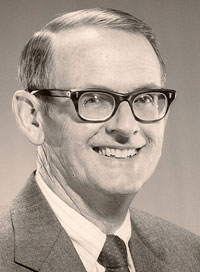

|

|
IN MEMORIAM
Frederick Sterling Sherman
Professor of Mechanical Engineering, Emeritus
UC Berkeley
1928 – 2008
Frederick (“Rick”) S. Sherman died on October 27, 2008, of a combination of cancer, pneumonia, and a mild stroke. He was 80 years old. Professor Sherman, an internationally renowned fluid mechanician, retired from the Department of Mechanical Engineering in 1991.
Rick was born April 14, 1928, in San Diego, California, where he attended local schools. After high school, he enrolled at Harvard College where he graduated cum laude with a bachelor’s degree in engineering science and applied physics. While at Harvard, he was elected to Phi Beta Kappa and was a member of the crew team. Migrating back to California, he continued his education at the University of California, Berkeley. On June 27, 1953, he married Patricia Malone. In 1950, he earned a master’s degree and in 1954 a Ph.D., both in mechanical engineering. He then became an instructor in the Department of Mechanical Engineering, although this faculty position was interrupted in 1956 by a two-year appointment as the head of the Aeromechanical Research Program in the Office of Naval Research in Washington, D.C. In 1958, Sherman returned to Berkeley as an assistant professor of mechanical engineering. He was promoted to associate professor a year later and to professor in 1965.
When Dr. Sherman joined the Berkeley faculty (1954), he and his colleagues conducted pioneering research on the behavior of rarefied gases encountered at very high altitudes. This team of aeronautical and space scientists, led by engineering professor Samuel Schaaf, used low-density wind tunnels to replicate the conditions that satellites and spacecraft encounter in the upper atmosphere. This research, extending into the 1960s, played a monumental role in the early years of the U.S. space program. Understanding aerodynamic forces in an environment where there are few air molecules was and is critical for optimizing the function of satellites in orbit and space craft in general. It was apparent that no one would venture to launch a $200 million hardware package into orbit without knowing how it would behave while there. At the time, Berkeley was one of the leading institutions in the world looking at these problems. The resolution of such questions has made possible today’s Geographical Positioning System and Geographical Information System devices, TV broadcasting, and other technologies that rely upon satellites for relaying signals. Sherman’s research also influenced the era of supersonic flight. In particular, Rick did seminal research on the behavior of shock waves when gases go from subsonic to supersonic conditions, causing the phenomenon known as the sonic boom. Understanding shock wave behavior is essential in designing aerodynamic shapes for supersonic flight, and such knowledge is now taken for granted. Shortly before he retired, Rick finished a text (senior/graduate level) on Viscous Flow.
As a faculty member, Rick contributed generously to administrative responsibilities and was known as an excellent teacher. In 1961, he was awarded the Academic Senate’s Distinguished Teaching Award. From January 1974 through June 1981, Sherman served as an assistant dean in the Office of Research Services of the College of Engineering. In this capacity, he was in charge of the off-campus Richmond Field Station. While this facility was largely used by engineering personnel, there was a group of biologists who were carrying out research on the grasslands at the station. This grassland is very special, as it represents the sole surviving remnant of the grassland community that covered much of the East Bay lowlands before the advent of Europeans to the area, and therefore supports important ecological research. Rick was quick to recognize and appreciate the value of this research, and on numerous occasions during his tenure as director of the station, he protected these research areas from intrusions by maintenance vehicles and various research groups that inadvertently invaded the grassland experiments. His generosity and understanding were much appreciated.
After Rick retired, he devoted most of his extraordinary talents to two other passions, genealogical research and folk dance. He joined the California Genealogical Society in 1980 and served as its president from 1994 to 1996. After that he was appointed its director of research. In this capacity he not only conducted his own investigations, but generously gave much time to researching for others. He even made special trips to the archives in Salt Lake City largely on behalf of others. At one point the society’s office in San Francisco was badly in need of additional space, and so Rick and his wife Pat donated funds for acquiring the needed room. This has been called the Frederick and Patricia Sherman room. He was also a member of the Society of Mayflower Descendents. Additionally, Rick was an avid and skilled folk dancer. He joined the Berkeley Folk Dancers in 1976 and was a stalwart contributor to the club until a few weeks before his death. He was president in 1982 and 2001, secretary in 1980, a teacher from 1990 to 1997 and again in 2005 to 2006. He also served on many key committees. Always, he was generous with his time, helpful in innumerable ways, and one of those key players in the dance community who will be genuinely missed.
Rick Sherman is survived by his wife of more than 55 years, Pat, two sons, John and Brad Sherman, and two grandchildren.
William Z. Lidicker, Jr. 2009
Stanley A. Berger
Omer Savas